|
Friday, May 27
- Breakfast: Chorizo burrito
- *Italian vegetable soup
- Teriyaki chicken
- Southern fried chicken
- *Mediterranean baked tilapia
- Eggplant parmesan panini
- Assorted sliced pizza
- Assorted sub sandwich
Wilson Hall Cafe Menu
|
|
Friday, May 27
Closed
Chez Leon Menu
Call x3524 to make your reservation. |
|
June wellness, fitness, pool information, and discounts
This month, the Wellness Office will sponsor the following free events:
- Walk 10,000 Steps-a-Day. Register and log your steps for weekly prize drawings.
- Lunch & Learn about Migraines and Cluster Headaches on Wednesday, June 15, in WH2W, Curia II from noon – 1 p.m. Presenter: Tony Leazzo, D.O.
- Qigong, Mindfulness & Tai Chi Easy® for Stress Reduction classes from 7 – 8 a.m. on Wednesdays in Ramsey Auditorium; and from noon – 12:45 p.m. on Fridays in Ramsey Auditorium.
This month, the Wellness Office will sponsor the following fitness classes:
- Yoga: noon - 1 p.m. Thursdays, June 9 – July 28 at the Wilson Hall Auditorium. Fee is $85/person. Yoga is now offered on Thursdays also.
- Yoga: noon - 1 p.m. Tuesdays, June 21 – August 9 at Wilson Hall Auditorium. Fee is $85/person.
The Fermilab pool opens June 7. Activities and membership information:
Pool memberships are available in the Wellness Office, WH15W.
- Pool membership cost: $90/person; $210 for a family of four; additional family members are $30.
- Aqua Tots is a water acclimation class for ages 1-3. This class will take place from 10:45 – 11:15 a.m. Monday – Thursday, June 13-16 and June 20-23. Fee is $65/child.
- Preschool swim lessons for ages 3-4 will take place from 10-10:30 a.m. Monday – Thursday, June 13-16 and June 20-23. Fee: $65/person.
- Youth beginner swim lessons for ages 5-12 will take place from 9-9:45 a.m. Monday – Thursday, June 13-16 and June 20-23. Students will be tested on first day of class and placed in appropriate beginner level class. Fee: $65/student.
- Adult beginner swim lessons will take place 11:30 a.m. – 12:15 p.m. on Mondays, June 13 – Aug. 8 (no class July 4). Fee: $65/person.
- Adult water aerobics will take place from 11:30 a.m. – 12:15 p.m. on Mondays, June 13 – Aug. 8 (no class July 4). Fee: $65/person.
- Open Water Scuba Diving Certification is offered from 5-8 p.m. on Wednesdays, June 15 – July 27 from 5-8 p.m. Fee: $260/person payable to Fermilab. $70 book and packet fee to instructor on first day of class.
Learn more about the pool and classes offered.
Athletic leagues:
- Ultimate Frisbee takes place beginning at 5 p.m. on Mondays and Wednesdays at the Village soccer field. For more information contact Joe Haley.
Employee discounts:
- Six Flags Great America, GiftTree.com, Jazzercise, Movie Tickets, Great Wolf Lodge, Rosati’s of Batavia. More information online.
|
New employees - May 23-24
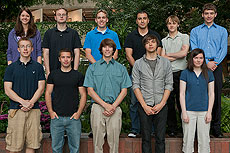 |
|
First row, from left: Will Parkin, Alex Irigoyen, Grant McDonal, Mikhail Moibenko, Lindsey Whiting. Second row, from left: Sara Graden, Anthony Podkowa, Kyle Beczkiewicz, Jose Gallegos, Steven Troscinski, Tom McLaughlin. Credit: Cindy Arnold. |
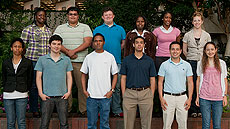 |
|
First row, from left: Courtney Clarke, Edgar Nandayapa, Blake Powell, Alex Matta, Raul Campos, Jen Karkoska. Second row, from left: Kayla Malone, Matthew Alvarez, Charles Orozco, Jackline Koech, Diana Perea, Stephanie Hamilton. Credit: Cindy Arnold.
|
|
The great cosmic-ray sniffer reaches orbit, on the hunt for dark matter
From TIME, May 25, 2011
For years, scientists have ridiculed NASA's claim that the International Space Station (or ISS) is a grand platform for groundbreaking research — and plenty of the science done there has just reinforced that attitude. Who can forget, for example, this classic opening sentence from a landmark 2006 paper in the Journal of Experimental Biology: "During space flights, tadpoles of the clawed toad Xenopus laevis occasionally develop upward bended tails (tail lordosis)"? If we hadn't spent tens of billions of dollars to construct the ISS, we might never have known that.
In fairness, though, the ISS can do science that's awe-inspiring rather than merely ewww-inspiring, and a 7.5-ton particle detector hauled aloft by the space shuttle Endeavour last week is poised to prove that point. Known as the Alpha Magnetic Spectrometer 2 (AMS-2), it will try to unravel a pair of long-standing mysteries, each of which is literally cosmic in its implications. The first: How much antimatter is out there in the depths of space? And the second: What is the mysterious, invisible dark matter that makes up a quarter of the known universe?
The answer to both could be wrapped inside cosmic rays — electrically charged subatomic particles that zip through the galaxy like interstellar bullets.
Read more
|
|
Tempest in a pinpoint
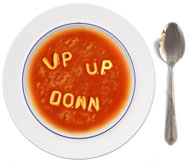 |
|
A proton contains two up quarks, a down quark and a soup of quark-antiquark pairs, seething below the surface.
|
It is often said that a proton is made of three quarks: two of the same type, called up quarks, and one of a different type called a down quark. But that's not the whole story. In the space between these three stable quarks there is a boiling soup of quark–antiquark pairs. That is, a quark and an antimatter quark spontaneously come into existence, drift a while, and then recombine, destroying one another. This happens all the time— in every proton in every atom of every cell of our bodies, and in all of the matter in the universe.
When two protons collide in the LHC, most of the individual quarks miss each other. Often only one quark or antiquark from each proton collides directly. When an up quark collides with an anti-down quark, the two can combine to form a W+ boson; similarly, a down quark and an anti-up quark can combine to form a W¯ boson. In both cases, an antiquark is involved. Thus, each of the millions of W bosons produced at the LHC must come from at least one of these transient particles, caught before it had a chance to sink back into the soup.
CMS scientists recently measured the ratio of W+ to W¯ production in proton collisions at the LHC. The number of W+ bosons exceeds the number of W¯ bosons by about 40 percent, partly because each proton has two stable up-quarks for every stable down-quark. However, the exact ratio also depends on the density of the quark-antiquark soup.
Counting W+ and W¯ bosons yields new insight into the dynamic structure of protons, which is too complicated to compute from first principles with current techniques. It also informs predictions of new physics: The rate at which hypothetical particles would be produced depends on the density of quark-antiquark pairs, for the same reason that W bosons do. It is important to know the thickness of this soup when imagining what else might spring from it.
— Jim Pivarski
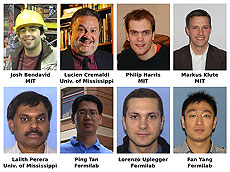 |
|
The U.S. physicists pictured above contributed to this analysis, which required input from around the world.
|
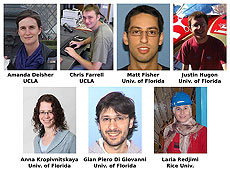 |
|
The above physicists had important roles in developing and maintaining the Level 1 Endcap Muon Trigger, which recorded many of the collision events used in this analysis.
|
|
Chu hopes kids will encourage families to go green
From NPR, May 26, 2011
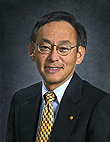 |
|
Steven Chu
|
Energy Secretary Steven Chu is launching an initiative to educate students about energy efficiency. He talks to Mary Louise Kelly about energy alternatives in an era of high gas prices, and about the future of the nuclear industry in the United States.
Listen
|
|